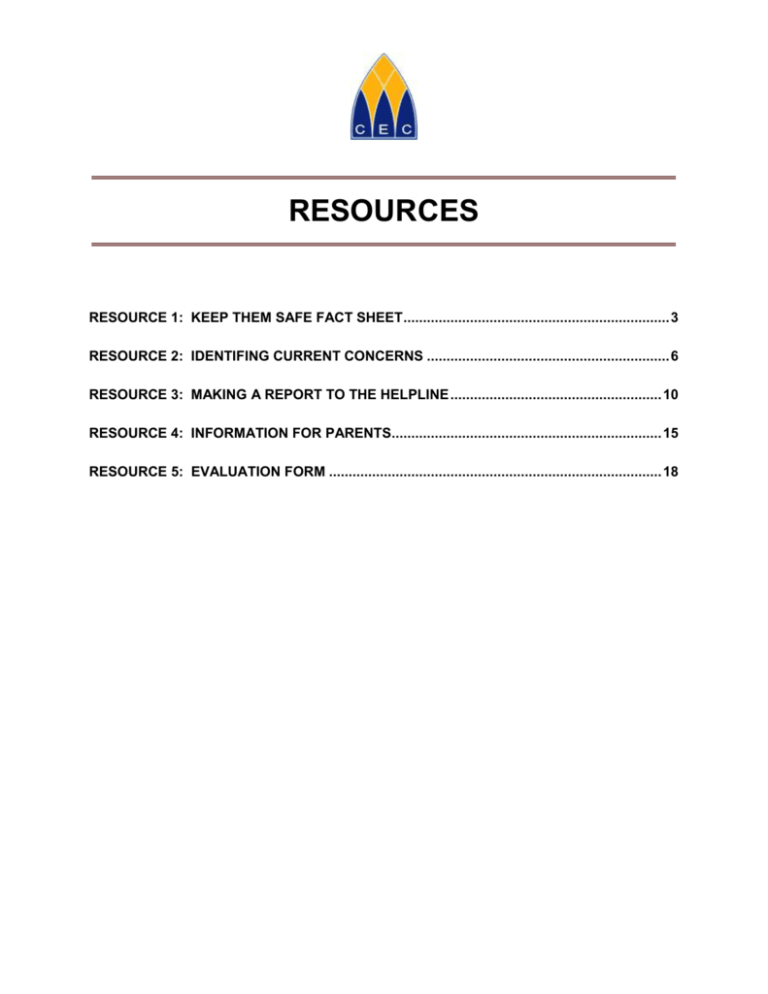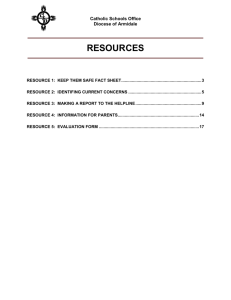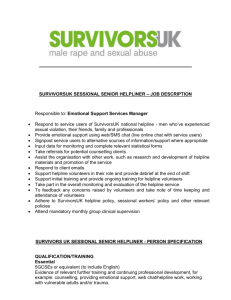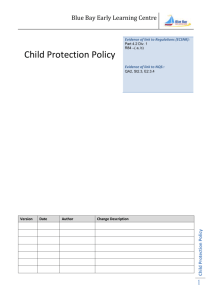Resources - Catholic Education Commission NSW
advertisement

RESOURCES RESOURCE 1: KEEP THEM SAFE FACT SHEET .................................................................... 3 RESOURCE 2: IDENTIFING CURRENT CONCERNS .............................................................. 6 RESOURCE 3: MAKING A REPORT TO THE HELPLINE ...................................................... 10 RESOURCE 4: INFORMATION FOR PARENTS..................................................................... 15 RESOURCE 5: EVALUATION FORM ..................................................................................... 18 Keep Them Safe Resources for Catholic Schools ACKNOWLEDGEMENTS KEEP THEM SAFE RESOURCES FOR CATHOLIC SCHOOLS © Catholic Education Commission NSW, April 2010 Written by Bronwen Elliott, Good Praxis Pty Ltd Design and Layout by Marguerite Grey, CEC NSW Proofreading by Dr Stephen Mondy and Kerry Martin, Centacare Broken Bay This material was developed with the assistance of the Catholic Education Commission Keep Them Safe Task Force: Kristin Johnston rsj Catholic Education and Social Welfare Consultative Committee (Chair) Ian Baker, Catholic Education and Social Welfare Consultative Committee (Executive Officer) Margaret Chittick, Catholic Education Office, Wollongong Jason Levin De Graaff, Catholic Schools Office, Broken Bay Cathy McClellan, Catholic Education Office, Parramatta Narelle McMahon, Catholic Education Office, Sydney Kerry Martin, Centacare Broken Bay Material from Centacare Broken Bay Keep Them Safe: Working with the Children and Young Persons (Care and Protection) Act Training and Policy and Procedures included with permission. Keep Them Safe Resources for Catholic Schools RESOURCE 1: KEEP THEM SAFE FACT SHEET Keep Them Safe Resources for Catholic Schools Keep Them Safe Fact Sheet No 7: The Mandatory Reporter Guidance – Page 1 Keep Them Safe Resources for Catholic Schools Keep Them Safe Fact Sheet No 7: The Mandatory Reporter Guidance – Page 2 Keep Them Safe Resources for Catholic Schools RESOURCE 2: IDENTIFING CURRENT CONCERNS Keep Them Safe Resources for Catholic Schools IDENTIFYING CURRENT CONCERNS ABOUT CHILDREN AND YOUNG PEOPLE School staff are responsible for reporting to NSW Community Services where they have reasonable grounds to suspect that there are current concerns that a student is at risk of significant harm. Many situations and issues raise concerns for school staff and other members of the school community such as parents and other students. Not every situation that raises concerns will warrant a report to the Child Protection Helpline and a statutory response from Community Services. Think of when you notice a set of traffic lights. It doesn’t necessarily mean it’s time to stop. It will depend on whether the traffic lights are red, orange or green. RED LIGHT: STOP AND REPORT Before contacting the Child Protection Helpline reporters should check that their concerns meet the threshold of risk of significant harm by checking with the Mandatory Reporter Guide. Generally in a school concerns are reported to the school principal and the Mandatory Reporters Guide will be used before contacting the Child Protection Helpline. For example, the following concerns will generally meet the threshold for reporting: Neglect circumstances such as leaving a young child alone, or leaving them in danger, or where a parent/carer is chronically or unreasonably inattentive. A child/young person with no safe place to stay, or whose parents are not meeting their basic needs such as shelter, food, clothing or medical care. Direct disclosure by a child/young person or another person of significant nonaccidental injury. Non-accidental injury where a child is under 5 or has a significant disability, or where a child/young person is refusing or is afraid to go home, or significant injuries that appear suspicious, or where there are significant risk factors for physical abuse due to threats to kill or injure a child, or dangerous actions or use of physical discipline towards a child. Clear direct description of sexual contact or non-contact behaviours (such as deliberate exposure to pornography) or evidence of sexual abuse such pregnancy or genital trauma or where a child/young person has contact with a known sexual offender. A child who has been exposed to traumatic events, domestic violence or parental substance use or mental health concern where there is evidence that they are suffering serious psychological harm. A serious incident of domestic violence in a household such as violence involving a weapon, threats or actual violence, or where a child/young person has attempted to intervene, or been physically close to the violence or where a child/young person was significantly upset by domestic violence. Keep Them Safe Resources for Catholic Schools Where families have discontinued involvement with services that were attempting to address concerns associated with risk of significant harm. Check the Mandatory Reporter Guide where there are concerns about a child/young person whose parents will not resume their care, or where there are concerns about a parent’s mental health or substance abuse, or where there are concerns about the parent’s capacity to care for a child/young person who is not yet born. ORANGE LIGHT: WAIT AND BE ALERT Sometimes there are grounds for concern, but not currently to the degree that meet the threshold for reporting to Community Services. In such circumstances school staff are able to watch out for the student and be alert to new information, or signs that concerns are escalating. For example: Where services are seeking to address concerns that might otherwise warrant a report of risk of significant harm such as safer approaches to discipline, increased attentiveness to supervision, basic shelter or nutrition, or necessary medical care. Child/young person has been exposed to situations that may be associated with significant harm but has not shown signs of distress that would be necessary to reach the threshold for reporting, or where there are other protective factors that function to reduce risk, e.g. exposure to domestic violence that is not yet chronic or severe, parental mental illness or substance use where one parent is able to be protective. Mothers who have been reported prenatally and where services are involved to assist the mother to address concerns. Where reporters are uncertain about the best response to a student or their family they should check the Mandatory Reporter Guide and contact the Child Protection Helpline if they continue to have significant concerns. Remember that you can always contact the Child Protection Helpline, regardless of the Mandatory Reporter Guide decision. GREEN LIGHT: GO ON – EXERCISE A PASTORAL OR OTHER SUPPORTIVE ROLE AS NEEDED Not all situations involving concerns about children are child protection issues. Sometimes families will face difficult situations that cause children distress, but will continue to manage these issues drawing on their own resources and those of their community. Sometimes families will have had challenges in the past but there will no longer be current concerns of risk of significant harm, even though past concerns still have some impact. Keep Them Safe Resources for Catholic Schools For example: A student tells a staff member about having been sexually abused. Community Services have been previously advised, the student’s parents have acted protectively and the student had helpful involvement with a counsellor with whom they can reengage if required and no further contact with the abuser. There are no current concerns, and issues should be addressed if and when they arise in the future. A student’s father dies. The student is very distressed, and receives extensive support from their family and the school community. It takes time, but the family continues to meet the student’s basic needs and provide a safe environment so there are no reasonable grounds to be concerned about risk of significant harm. A student presents behaviour issues at school. His parents have some complaints about the approach of one of his teachers but generally co-operate with the school authorities and support a referral for assistance from the school counsellor. A student is affected by trauma arising from their experiences as a refugee prior to arriving in Australia. With their family they are receiving services from a support service, and their parents continue to meet their basic needs and support their attendance at school. The school has a role in providing support for the student but these concerns do not warrant a report. For further information refer to the Child Wellbeing and Child Protection NSW Interagency Guidelines. Keep Them Safe Resources for Catholic Schools RESOURCE 3: MAKING A REPORT TO THE HELPLINE Keep Them Safe Resources for Catholic Schools MAKING A REPORT TO THE CHILD PROTECTION HELPLINE INFORMATION SHEET 1. What is the Child Protection Helpline? The Child Protection Helpline is part of Community Services (CS, formerly the Department of Community Services or DoCS), which is an agency of the NSW Department of Human Services. The Child Protection Helpline accepts: Reports of risk of significant harm (except relating to school enrolment or attendance – see (7) below) Prenatal reports Reports of homelessness of a child or young person. 2. How do I know that a matter has reached the threshold for reporting risk of significant harm to the Child Protection Helpline? The Mandatory Reporter Guide (MRG) is a decision making tool to help reporters identify risk of significant harm. You can access the MRG online, or you can download a hard copy PDF at www.keepthemsafe.nsw.gov.au/. The Mandatory Reporter Guide consists of a series of decision trees, or flow charts. You should choose the decision tree that best fits with your most serious concern about a child. The Guide provides a list of Yes/No questions that will guide you to a decision about reporting, or alternative responses. The decision options are: Report to CS Immediately: Contact the Child Protection Helpline directly. If you receive this advice do not use additional decision trees for further concerns, but document those concerns and pass them on to the Child Protection Helpline. Report to CS: Contact the Child Protection Helpline within 24 hours. Consult a professional: Follow CSO/CEO advice regarding identifying a relevant professional. Document and continue relationship: Record the MRG decision following CSO/CEO policies and procedures. Be alert to changes in the student or family circumstances which could indicate increased risk, and consider ways in which you can assist the student and/or parent, including through referral, school based programs or liaison with other agencies. Document and monitor: This decision relates to school attendance concerns that do not reach the reporting threshold. Record the MRG decision following CSO/CEO policies and procedures. Monitor the effectiveness of efforts to address or increase attendance, and be alert for additional significant risk circumstances. Be aware that there may be more than one decision tree that is relevant to your most serious concern, and you may need to check several decision trees before you reach a Report decision, particularly where there are neglect or carer concerns. Keep Them Safe Resources for Catholic Schools Regardless of the decision from the MRG, you can still contact the Child Protection Helpline if you have professional concerns about a child or young person. It may be that your concerns relate to circumstances that are not covered by the decision trees and the safety and wellbeing of children and young people is always the paramount concern. The MRG allows you to print a decision form, including the basis for the decision and information about additional concerns. If you are making a report as a mandatory reporter, staff at the Child Protection Helpline will ask you whether you have used the MRG when they take your call. They will also ask you for all the details about your concerns for the child or young person. 3. How do I contact the Child Protection Helpline? Contact the Child Protection Helpline on 133 627. This is a dedicated line for Mandatory Reporters. The general public can contact the Child Protection Helpline on 132 111. 4. What records should I keep about reports to the Child Protection Helpline? You should follow CSO/CEO policies and procedures. Usually this will mean documenting the report using a standard Report of Risk of Significant Harm form. Ensure that you document all concerns, not only those that triggered the reporting decision. You should also document any feedback regarding the report, any contact with other agencies in relation to the concerns in the report, and any action that arises as a result of the report. This information should be kept in a confidential place. These records need to remain at the school when you leave so they are available to future school staff. You may also be required to send copies of records about the report to the CSO/CEO. 5. What feedback can I expect from the Child Protection Helpline? You will be advised whether your concern meets the threshold for risk of significant harm, and the likely Community Services response. You can ask for guidance from the Child Protection Helpline about what to do if you are concerned about a student going home that day, or about what to tell a student or parent. 6. What is the law regarding reports to the Child Protection Helpline? The Children and Young Person’s Care and Protection Act 1998 provides the legal framework for reporting to the Child Protection Helpline. The Act can be found at www.legislaton.nsw.gov.au. Mandatory reporting (s.27) The law requires people in certain employment or management categories to make reports of risk of significant harm to the Child Protection Helpline. People who deliver, or supervise the delivery of education services wholly or partly to children aged under 16 years must make a report to the Child Protection Helpline where they identify risk of significant harm in the course of their paid or professional work. This means any paid staff or contractors with day to day contact with students will be mandatory reporters, as well as all executive staff. Keep Them Safe Resources for Catholic Schools Risk of significant harm (s.23/4) Risk of significant harm exists where there are: 1. Current concerns 2. Reasonable grounds 3. The presence to a significant extent of one or more of: Child’s basic needs not met or at risk of not being met Parent not arranging necessary medical care Parent not arranging for a child to have an education Child has been, or is at risk of being physically or sexually abused or ill-treated Risk of serious physical or psychological harm where a child is living in a household where there is domestic violence Behaviour of parent or caregiver causes child to suffer or be at risk of suffering serious psychological harm Prenatal concerns where a mother has not engaged successfully with support services to address risks in spite of a previous prenatal report. Situations where a parent has made voluntary care arrangements for their child that are not lawful. Risk of significant harm can relate to a single act or omission or an accumulation of these. Prenatal reporting s.25 Reports about an unborn child can be made to the Child Protection Helpline where the child may be at risk of significant harm after birth. The purpose of reporting is to provide assistance for the expectant mother, and early identification of children where there are concerns about risk of significant harm. Reporting is mandatory after a child is born where a mother has not responded to a s.25 report. Protection for reporters s.29 Reports to Community Services are confidential and the reporter’s identity (if known) is protected by law providing the report is made in good faith. Reporting is not a breach of professional etiquette, ethics or standards, and a reporter cannot incur liability for defamation or be compelled to give evidence in court about their report. Reports are exempt under the Freedom of Information Act 1989. If law enforcement agencies require the identity of a reporter in order to investigate serious offences alleged to have been committed against children or young people, the identity of the reporter may be released to the police. Homelessness of a child or young person s.120-121 The law says reports of homelessness of a child or young person may be made to the Child Protection Helpline. Reports of a homelessness relating to a young person can only be made with the young person’s consent. Reports of homelessness under these sections are not mandatory and would only be made where a report of risk of significant harm did not apply. Keep Them Safe Resources for Catholic Schools Mandatory reporting of homelessness of a child s.122 Any person providing accommodation for a child (i.e. under age of 16 years) must advise the Child Protection Helpline where their parent has not been informed of their whereabouts. 7. Are Catholic school staff obliged to make reports of risk of significant harm regarding young people? Although mandatory reporting by law only applies to children under 16 years, it is expected that Catholic schools will make reports where risk of significant harm is identified in relation to any student aged 17 years or under. The Child Protection Helpline cannot accept reports about students aged 18 years or over as they are not covered by the legislation. Keep Them Safe Resources for Catholic Schools RESOURCE 4: INFORMATION FOR PARENTS Keep Them Safe Resources for Catholic Schools KEEP THEM SAFE INFORMATION FOR PARENTS What is Keep Them Safe? Keep Them Safe is a new initiative introduced by the NSW government after an inquiry into child protection in NSW. The inquiry recommended that Community Services* should focus attention on children in the most concerning situations and that other families in need should be referred to other government departments and community agencies who could provide them with help. The inquiry recommended changes to laws and programs affecting families with children across NSW. These changes will be put in place over the next five years and will include increased funding for services for children, young people and families especially for young children and for Aboriginal families. The Keep Them Safe website www.keepthemsafe.nsw.gov.au provides details of the changes. * (Community Services is the new name for the government Child Protection agency previously known as DOCS) How has reporting to the Child Protection Helpline changed? From January 24 2010 the focus of the Helpline changed to reports of risk of significant harm. This means that Community Services will no longer follow up reports unless they reach this threshold. A new tool called the Mandatory Reporter Guide now helps agencies working with children and families to decide whether a report is necessary. Anyone can access the Mandatory Reporter Guide on the web at www.keepthemsafe.nsw.gov.au. The aim is to focus Community Services’ time and resources on families and children who most need help. Previously many families were reported because there was a law that could result in employees such as police, doctors, teachers and counsellors being fined if they did not report. These employees are now only required to report children at risk of significant harm and the fine has been removed from the law. Reports are not compulsory for young people aged 16 – 17 years but many organisations such as school will also make reports where they are concerned about young people at risk of significant harm. It is important to be aware that even with the changes most children who are reported to Community Services will remain in their parents’ care. Only a small number of children are removed from parents through Community Services’ involvement and most of them will either return to their parents, or be in the care of close relatives. Government agencies that previously made the most reports to the Helpline will now have the support of Child Wellbeing Units (CWUs). Staff from departments such as Police, Health and Education and Training will get assistance to find the best help for families where reports to the Helpline aren’t necessary. They will also keep a database of families referred to the CWUs to help identify children at risk of significant harm. Nongovernment agencies such as Catholic schools will not have CWUs because they only report a relatively small percentage of children each year. There are plans for nongovernment agencies to have access to other services if they need advice about finding help for children and families. Keep Them Safe Resources for Catholic Schools What will change about sharing of information by agencies? The Special Commission of Inquiry into Child Protection found that laws about confidentiality in NSW made it hard for agencies to exchange information even where this could protect children from being abused. For example police could not give schools information that would help them make informed decisions about employment of staff, or about programs for students with significant behaviour problems. Where agencies such as schools and health providers were working together closely to meet student’s needs it was sometimes impractical to comply with rigid legal requirements about exchanging information. The NSW government has followed the inquiry’s recommendations and changed the law in October 2009 so that a range of organisations (known as ‘prescribed bodies’) can share information related to the safety, welfare and wellbeing of children aged 0-15 years and young people aged 16-17 years regardless of whether they have the formal consent of the child or young person or their parents or carers. This may include information about parents and other people if it is relevant to the safety, welfare or wellbeing of children or young people. Organisations can only share this information if it helps them to make plans or decisions, complete assessments or investigations or assists in other ways to provide services that children and young people need. If they exchange information about children, young people and families without consent for any other reason they may be in breach of the Privacy Act. The new law does not cover Federal government agencies such as Centrelink or the Family Court but will apply to government and non-government schools, and organizations that provide counselling and family services. The law may apply to health care providers such as doctors, depending on where they work. As a general rule, the best results for children, young people and families come where everyone involved is open and transparent about their activities including sharing of information between different organisations. Families should still expect in most situations that they will be involved in discussions about sharing information, but they may no longer need to sign formal consents for information sharing. The most likely situations where information will be exchanged without consent would be in emergencies where information is needed urgently, or where information needs to be shared confidentially to protect children or young people. There has been no change to requirements about parental consent for services to be provided to children, such as where primary school students are referred to school counsellors. To find out more about changes to information exchange legislation go to www.keepthemsafe.nsw.gov.au. Keep Them Safe Resources for Catholic Schools RESOURCE 5: EVALUATION FORM Keep Them Safe Resources for Catholic Schools TRAINING EVALUTION Date: Module: 1. How would you rate the training presentation? 1 2 3 4 Very poor 5 Excellent 2. How would useful was the training content? 1 2 3 4 Very poor 5 Excellent 3. How would you rate the training resources (i.e. handouts PowerPoint slides) 1 2 Very poor 3 4 5 Excellent 4. What will you use from this training in your work with students, families and/or school staff? 5. What additional learning needs do you have in relation to child wellbeing and child protection? Any other comments?



![Extreme Weather Conditions - Preventative Measures [doc / 272KB]](http://s3.studylib.net/store/data/007256003_1-f08a5267d9e865d85ddea6fe14d19a26-300x300.png)
